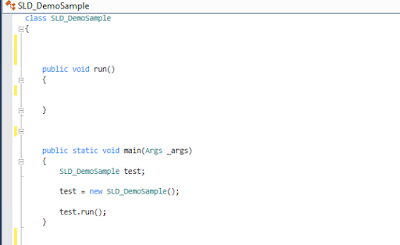Delegate Result with EventHandlerResult
In this article, we will show to get Results from delegate subscribe events.
In normal routine mostly Ax Technical use subscribe event of delegates and perform the required task and get the required result. Following are the few steps through them you can achieve the same.
Let's begin.
Step-1 Create a class with the name of SLD_DemoSample
Step-2 Add two methods Main and run in this class like below screenshot
Reference screenshot
Step-3 Create a delegate in the class with two parameters like below
delegate void showMessage(Description _msg, EventHandlerResult result) { }
Reference screenshot
Step-4 Subscribe to the event of newly created delegate and paste to the class
Reference screenshot
/// <summary>
///
/// </summary>
/// <param name="_msg"></param>
/// <param name="result"></param>
[SubscribesTo(classStr(SLD_DemoSample), delegateStr(SLD_DemoSample, showMessage))]
public static void SLD_DemoSample_showMessage(Description _msg, EventHandlerResult result)
{
result.result(strFmt("Message received from run method is %1",_msg));
}
Step-5 Use result object of EventHandlerResult class (2nd parameter) to return the response to caller like result.result(strFmt("Message received from run method is %1",_msg));
Reference screenshot
Step-6 Now call the delegate from the method and pass the required parameter like below.
EventHandlerResult result = new EventHandlerResult();
Description message='Hello world this is an event handler';
info('Before..');
this.showMessage(Message,result);
info(result.result());
info('After...');
Reference screenshot






No comments:
Post a Comment